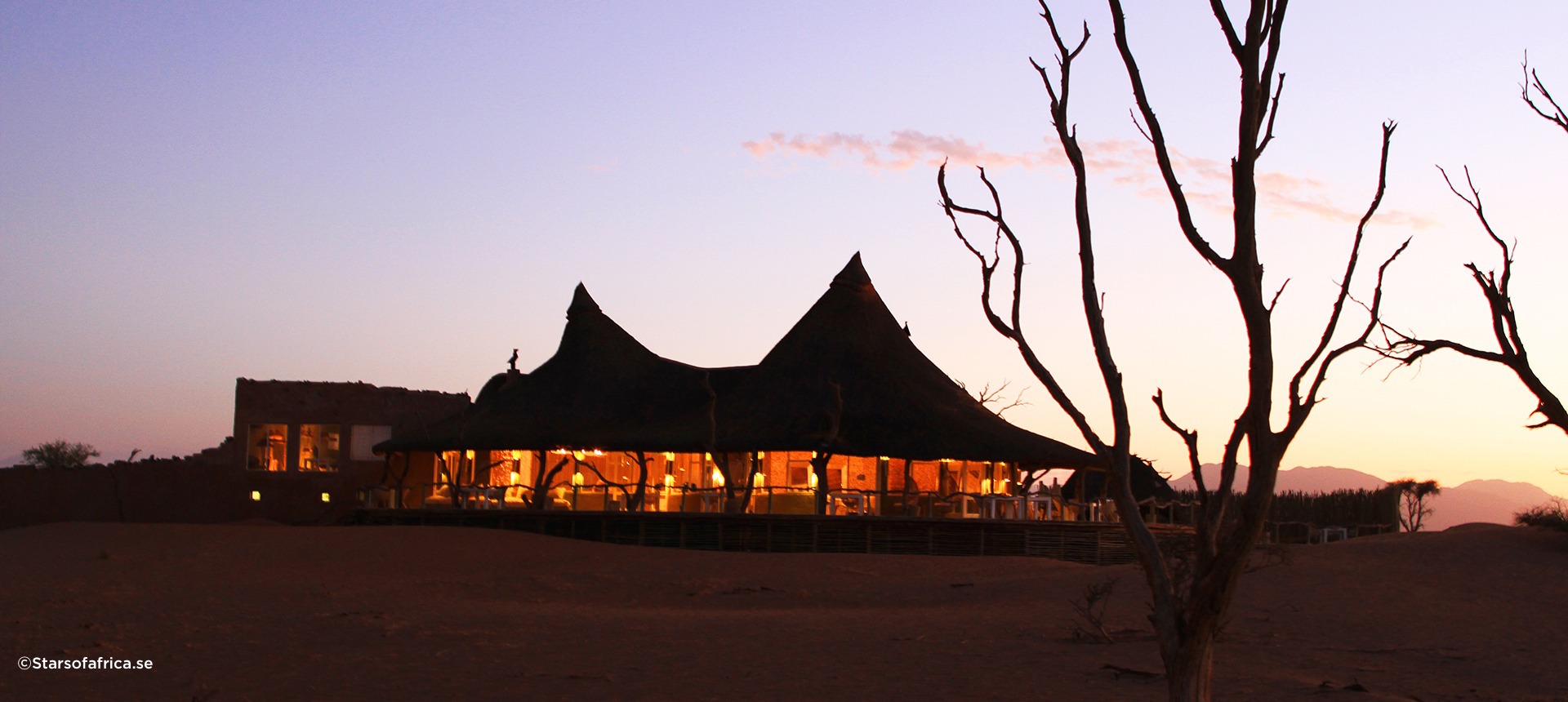LITTLE KULALA CAMP
THE PEACE AND MAGNIFICENCE OF THE NAMIBIAN DESERT MEET THE SIMPLE LUXURY OF AN ECO-RESORT
Little Kulala is a desert retreat situated in the private Kulala Wilderness Reserve – the gateway to Namib Sand Sea, with its towering burnt orange dunes and clear starry skies.
With its pleasurable exterior architecture and fabulous interior décor, the concept of the Camp is that of the desert. The interiors have been designed to provide an all-natural and unique experience in this most beautiful desert environment. The extensive use of neutral colors, textures and natural light reproduces the soothing pastel shades of the desert. Pure linen, cotton and mohair dyed with natural vegetable dyes all make for a highly organic camp that takes its inspiration from its surroundings, notably from the magnificent Dead Vlei in the middle of Sossusvlei. This Camp has a unique identity in a spellbinding landscape. It is easy to be seduced by Sossusvlei: the delicate, layered splendor of the desert at sunrise or sunset is exquisite; the scenery is exhilarating, so vast and so ancient. The pristine mountainous terrain on the horizon and the stillness can very well make the outward journey turn inwards, offering a sense of solitude and spiritual quality.
Little Kulala is open all year round.
ACCOMMODATION
Accommodation at Little Kulala consists of 11 climate-controlled thatched ”kulalas” (the word means ’to sleep’) with en-suite bathrooms, indoor and outdoor showers, private decks and plunge pools. Each kulala has a private rooftop for stargazing. Many guests enjoy sleeping in the open under the magic of the African night sky. The kulalas merge impeccably into the timeless desert landscape.
Dining
During the colder winter months, July to August, dinner is usually taken inside, where a crackling fire is in a large stone fireplace is lit, throwing off heat to keep everyone warm. During the warmer months dinner is enjoyed out on the deck under the magnificent Stars of Namibia.
CONSERVATION
In 1996, Wilderness Safaris set up an operation on land close to the spectacular Sossusvlei. As this locale had previously been used for subsistence goat farming, precious little indigenous wildlife remained. Yet after a program to remove the stock fences and exotic species, the wildlife slowly began to return. The area was then extended to adjoin the massive Namib Naukluft Park and become the Kulala Wilderness Reserve. With the creation of the Kulala Wilderness Reserve arose an opportunity to study and assess the rehabilitation of this 37,000 hectare/92,000 acre area after years of intensive farming. The Small Carnivore Research Project began in 2000, when bat-eared fox were studied on the Reserve as an indicator species for land rehabilitation. That study was followed by once of aardwolf, black-backed jackal, Cape fox and the African wildcat. This project is supported logistically by the Wilderness Camps in the Kulala Wilderness Reserve.
ACTIVITIES
The guides at Little Kulala are very passionate, knowledgeable, proud and dedicated to this most unique wilderness.
Guided drives
Activities at Little Kulala start with morning guided drives to the spectacular towering dunes of Sossusvlei, through a private entrance into the Reserve. Sossusvlei is situated within the Namib Desert – the oldest desert in the world – which itself is part of the Namib Naukluft National Park. Its renowned monumental mountains of golden orange sand dunes and flat valley floors make up the archetypical view of the Namib that is world famous.
Long ago, the San people followed the river here and found it full of plants, birds and animals. They called it Sossusvlei ’the gathering place of water’. But with the passing of time, the river changed its course, and now only a peculiar grove of skeletal camel thorn trees remains on the pan. The trees are carbon-dated to 600–900 years old, as the climate is too dry for them to decay. The dunes, with their razor-sharp edges that standing out against the azure blue sky, can rise to as high as 300 meters/984 feet above the valley floor.
Guided walks
Are offered on the private Kulala Wilderness Reserve with its magnificent scenic views and sightings of plants and wildlife specially adapted to these arid conditions; wildlife such as ostrich, springbok, oryx, bat-eared fox, black-backed jackal and the elusive aardwolf.
WILDLIFE
Desert-adapted wildlife such as ostrich, springbok and gemsbok are sparsely distributed around Little Kulala. Spotted and brown hyena and even cheetah are occasionally present, while smaller creatures such as bat-eared fox and aardwolf can be seen at night in the cool desert air. The dune lark has its entire global distribution limited to the area, so dependent is it on the area’s characteristic sands. A wide range of insects, reptiles and rodents make their home in this arid land; the call of the barking gecko at twilight is the quintessential sound of the desert.
PHOTOGRAPHY
The solitude of this vast, rugged epic desert landscape of wilderness, sunshine, blue skies, rolling red sand dunes and landscapes, makes for grand wide-angle photo opportunities.
From Little Kulala it is an easy access to the sights of the red sand sea of Sossusvlei – with its vivid colors, textures and shapes. The sheer scale and grandeur of the Sossusvlei dunes with razor-sharp edges that stand out against the blue sky remain an inspiring sight year-round, as does the dramatic and magnificent Dead Vlei with its black skeletal trees.
A pre-dawn start is essential as it is the soft light of the sunrise on the desert that photographers want to catch. Landscape photography opportunities abound in the cool mornings, with dawn’s early soft light first illuminating the dunes from crest down the back slope, then blazing orange everywhere, creating a powerful contrasting vista across the whole desert. The backdrop of intense blue skies, sweeping red dunes and the harsh foreground of the white mineral pans, offer photographers extreme contrasts for landscape photography.







